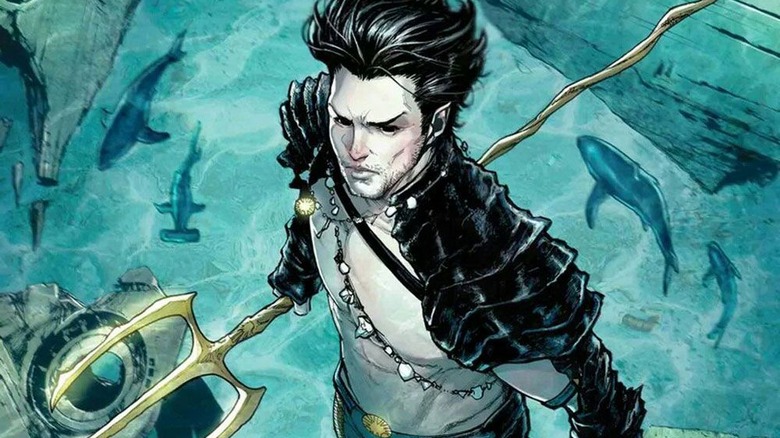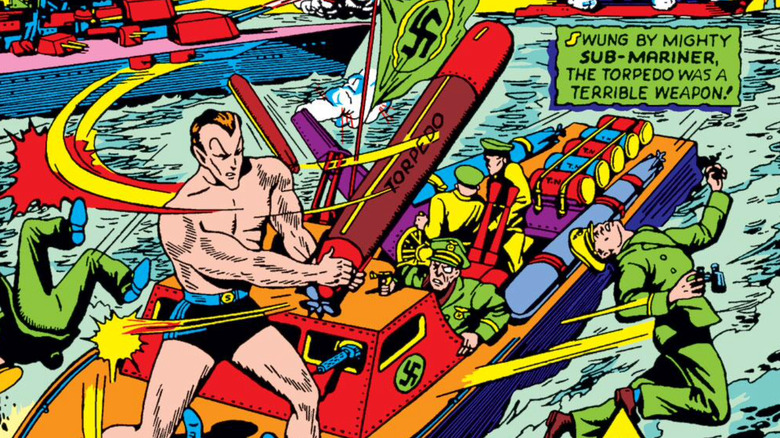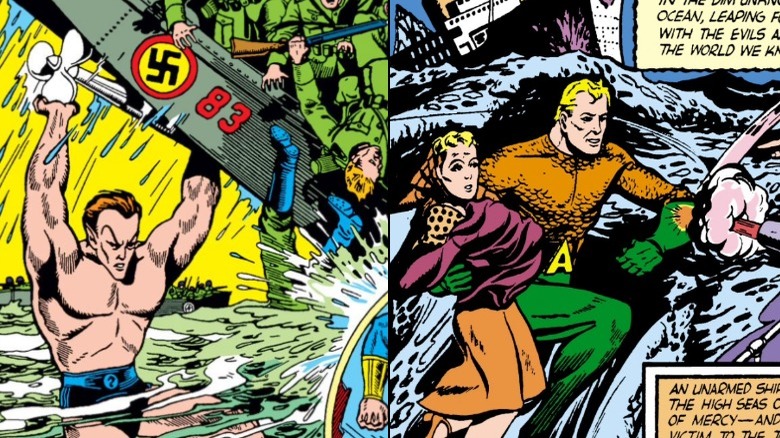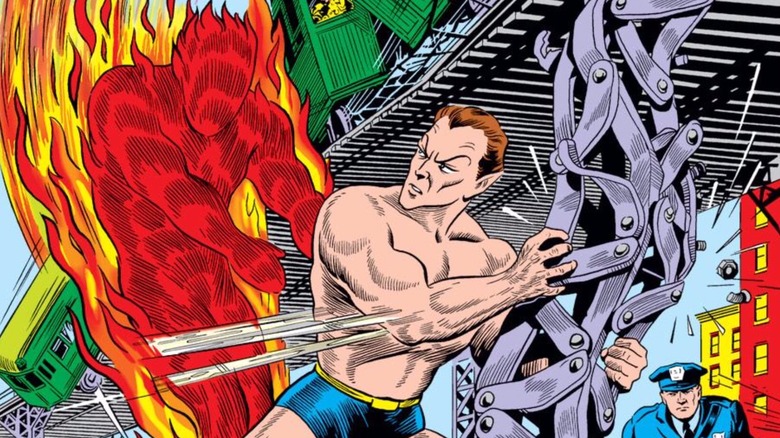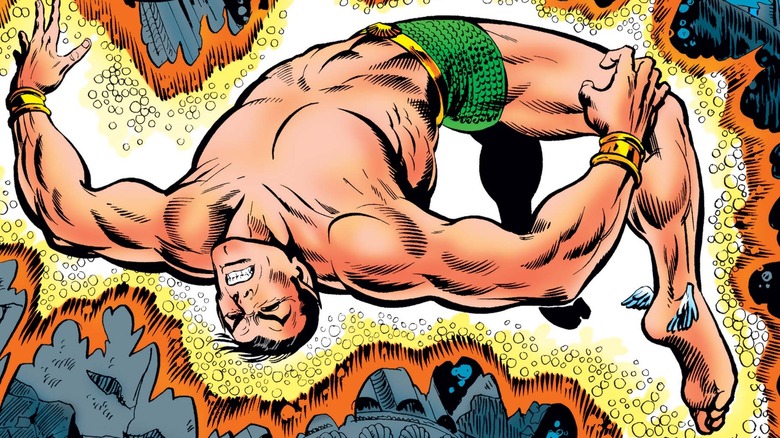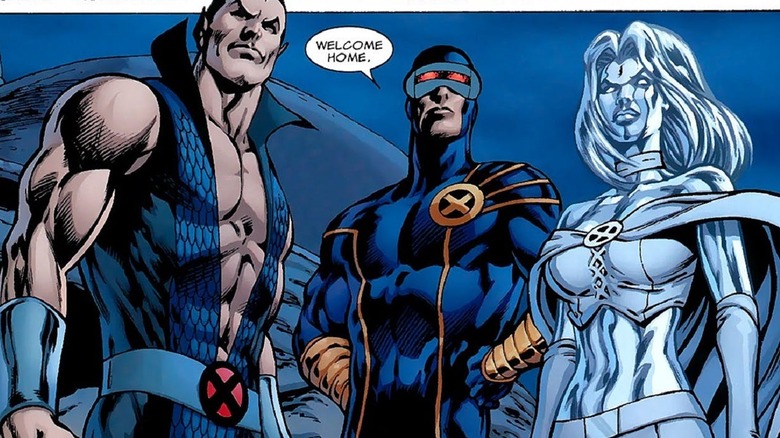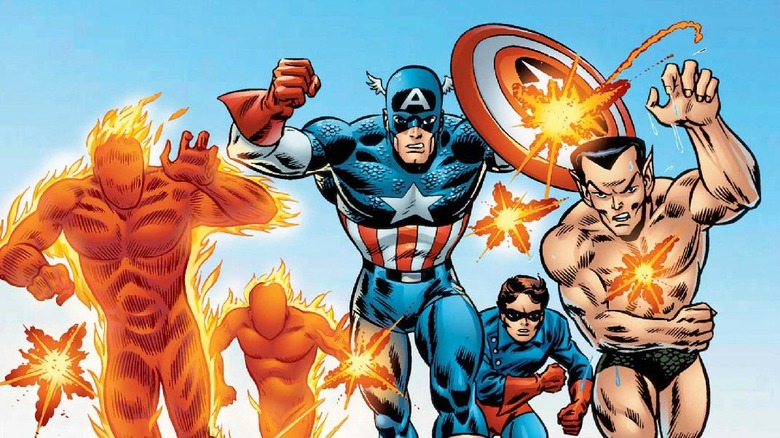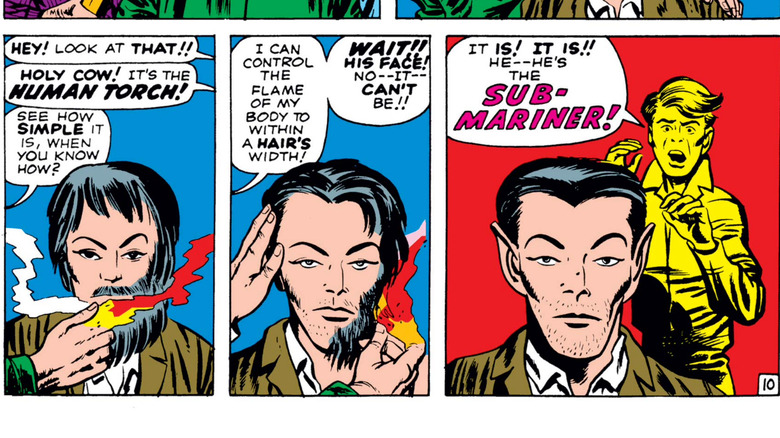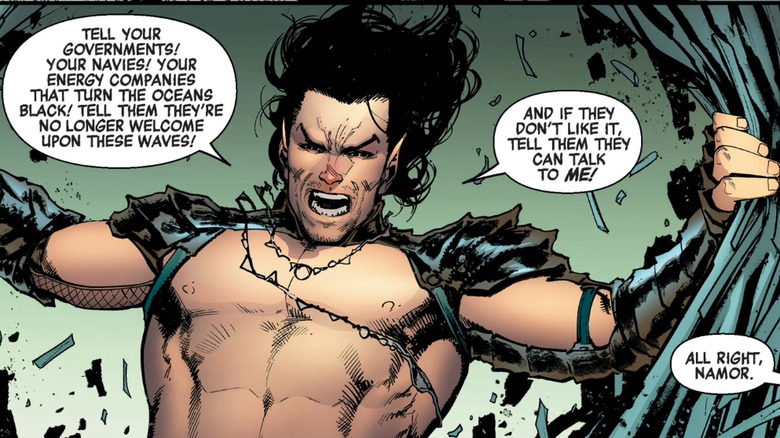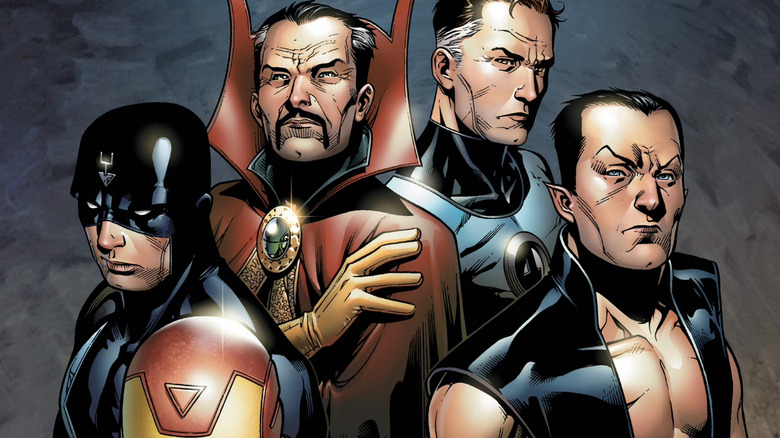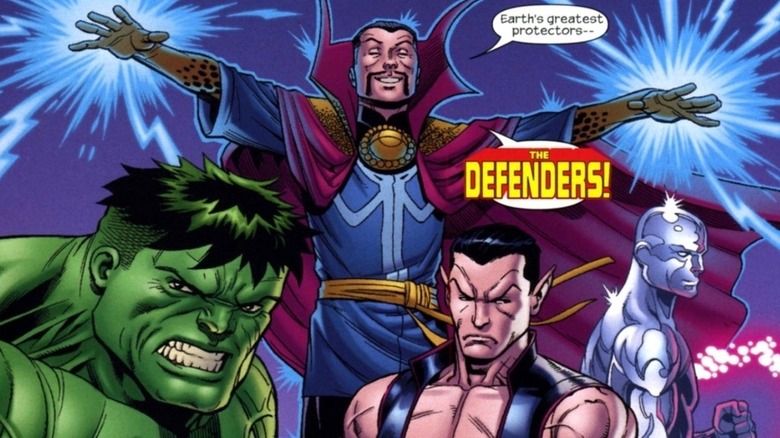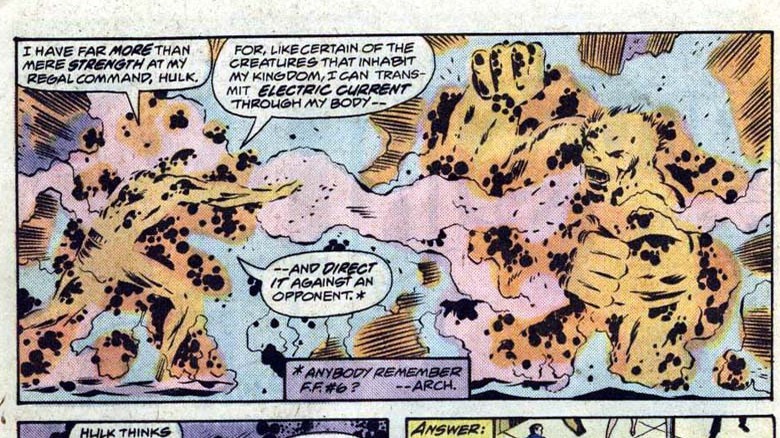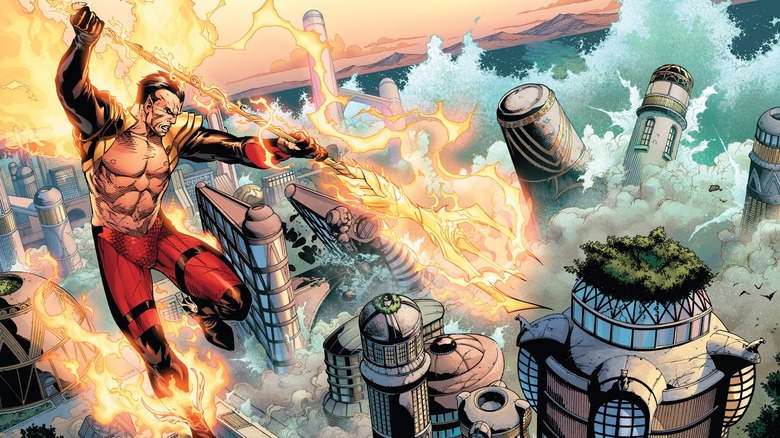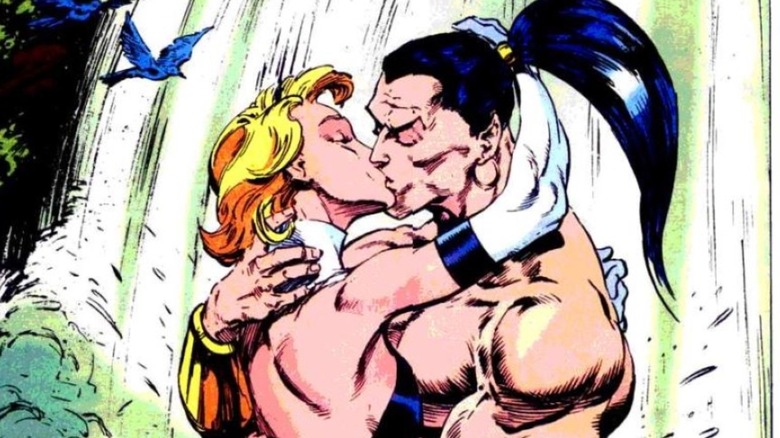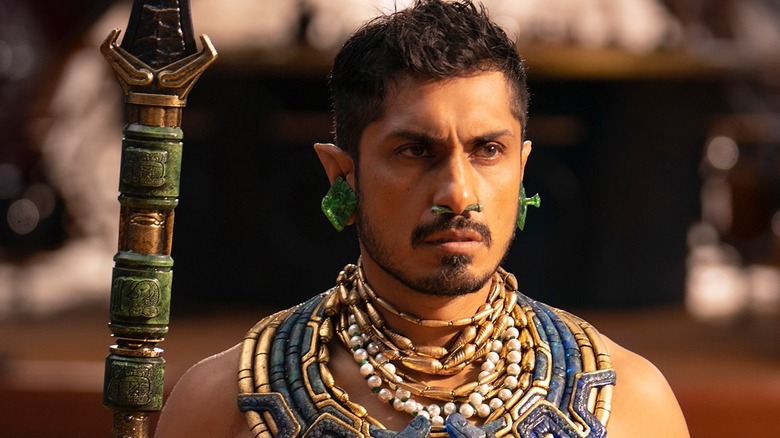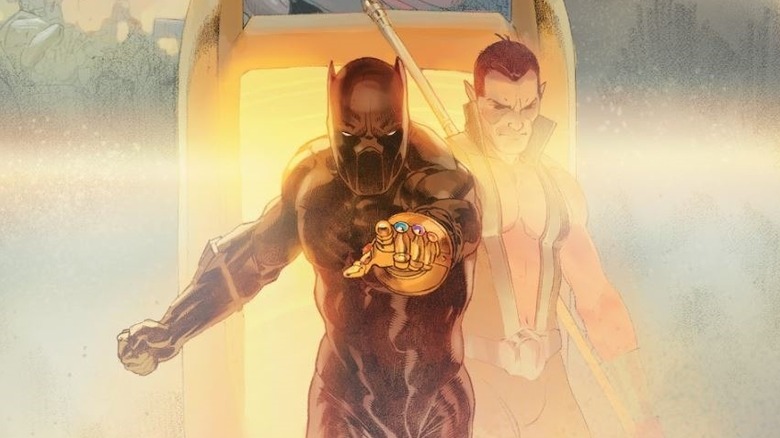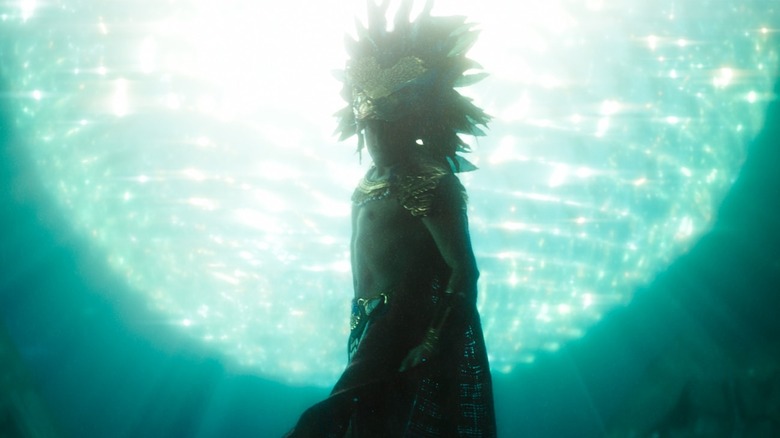Namor: Dive Into These Awesome Facts About Marvel's First Mutant
Namor has one of the more complex histories of Marvel's superheroic pantheon. The result of a union between the human Leonard Mackenzie and Princess Fen of the underwater empire of Atlantis, Namor is one of the most reclusive and volatile members of the Marvel Universe. He was one of the original Defenders and has enjoyed time in the Avengers, the X-Men, and the Fantastic Four, among others.
But the Sub-Mariner isn't known just for his heroism. Over the years, Namor has spearheaded multiple assaults on what he calls the "surface world," often locking horns with the same heroes who were once his allies. Recently, Namor and his new team of aquatic heroes and villains — the Defenders of the Deep — clashed with the Avengers, and his attacks on the surface continued in the "Invaders" arc. Now, the longtime Marvel character is making his big-screen debut in "Black Panther: Wakanda Forever," played by Tenoch Huerta.
Why would anyone think one of Marvel's first good guys would be making time on the dark side? To find out about that and more, keep reading the untold truth of Namor the Sub-Mariner.
Namor was one of Marvel's first heroes
Namor first appeared in 1939's "Marvel Comics" #1, an enemy to humanity from the very beginning. While in his underwater kingdom, Namor comes upon two salvage divers who he is convinced are robots because of their strange garb. He kills both divers and brings their bodies back to his people. Once he peels the diver suits off his victims, revealing they weren't robots after all, his mother in particular praises Namor for what he's done. She tells him humans almost caused their people to go completely extinct, and that she has long meant to wreak vengeance upon them.
By the time he gets his own series with 1941's "Sub-Mariner Comics" #1, Namor's vengeance is targeted at the Nazis. Hitler orders Namor's undersea home bombarded by U-boats, killing many of his people, including the Emperor. "Sub-Mariner Comics" #4 was published a month before the bombing of Pearl Harbor, and when "Sub-Mariner Comics" #5 came out in 1942, Namor had changed targets from the Germans to the Japanese, and the subsequent comics did not mark Marvel's finest moments. Like many comics of the time, "Sub-Mariner Comics" featured offensive depictions of the Japanese, a shameful fact Namor's old colleague Spitfire comments on as she browses through a stack of old comics in 1991's "Namor the Sub-Mariner" #19.
Contrary to popular belief, Namor is not a clone of Aquaman
If you haven't heard of Namor, one of the reasons may be that he's often overshadowed by DC Comics' more well-known aquatic hero, Aquaman. The two have a lot in common — they're both underwater heroes, both are the product of a union between humans and fictional undersea people, and each is the heir to the throne of his respective version of Atlantis. Even though they've both worked on the side of the angels, they each tend to harbor at least some sense of antagonism towards the surface world — though Namor clearly dominates in that department.
All of this has led to the false belief that the Sub-Mariner is a clone of the more popular Aquaman. In fact, if anything, it's the other way around — the Sub-Mariner first showed up in 1939's "Marvel Comics" #1, while Aquaman didn't surface in his orange-and-green get-up until 1941's "More Fun Comics" #73. Though Aquaman undoubtedly gained more popularity (and mockery) over the years while Namor's star dimmed, even beating him to the punch when it came to who'd make it to the big screen first.
However, there's no need to point and call names. The '30s and '40s saw comic book publishers trying any and every gimmick they could think of. It isn't that much of a stretch to assume two different comic book creators could've conceived of aquatic heroes without seeing one another's work.
Namor's clash with the original Human Torch created the Marvel Universe
These days, Marvel Comics has no end of line-wide events drawing together heroes from all over its universe. Even though reading the whole story means spending more money, crossovers remain popular. Part of the reason they still sell is because they affirm the idea that Marvel's fans are plugged into a large, complex fictional world. It could be argued that Namor was one of two heroes who created that world in the very first Marvel crossover.
Many superhero comics in Golden Age (i.e. the 1930s and '40s) were anthology comics — rather than just featuring stories of one hero, the comics were roughly three times longer than a modern comic book and offered readers multiple stories, each starring a different hero. In 1940's "Marvel Mystery Comics" #8, two of the title's heroes — Namor and Jim Hammond, the original Human Torch — meet and lock horns in a battle that lasts until the opening of "Marvel Mystery Comics" #10. The fact that the two could have a battle confirmed their stories took place in the same world and is often considered to be the story that established what we now call the Marvel Universe.
Namor was the creation of Marvel pioneer Bill Everett
Namor the Sub-Mariner was the creation of Bill Everett, who was reportedly a descendant of the poet William Blake (in fact, the artist's full given name was William Blake Everett). Poetry had a key role in the creation of the character, too: "The Sub-Mariner was based on the 'Rime of the Ancient Mariner' by Samuel Coleridge," Everett's daughter, Wendy, said in an interview. "[Everett] had read Coleridge and this background gave the characters a very erudite wholeness." In tribute to the character's origins and Everett's inspiration, "Namor the Sub-Mariner" #44 in 1993 loosely adapted Coleridge's poem for the comic book page.
According to the book "The Steranko History of Comics — Volume One," Everett conceived of the Sub-Mariner while working for Funnies, Inc. The book says Sub-Mariner was initially planned as part of a promotional comic that would be given to moviegoers at theaters. That idea was scrapped, and instead Everett used it for 1939's "Marvel Comics" #1. The hero was a hit, and Everett would go on to write and draw Sub-Mariner stories in "Sub-Mariner Comics," "Marvel Mystery Comics," "Blonde Phantom Comics," and "The Human Torch."
Everett took a break from Namor for decades but eventually returned to his stories. He ultimately ended up writing and drawing the character until the end of his life, working on Namor's stories in late '60s issues of "Tales to Astonish" and early '70s issues of "Sub-Mariner." Sadly, Everett passed away in February 1973. "Sub-Mariner" #61 — Everett's final issue — was published a few months later.
Namor was Marvel's first mutant hero
Over the years, one of the more contentious debates fans fielded over Namor is whether or not he's a mutant. He was, after all, born with his powers, and not all of his abilities can be explained by his shared Atlantean heritage. For example, while Atlanteans are naturally stronger than humans, Namor is even stronger. Also, Namor can fly — not an ability most Atlanteans share.
On the other hand, one major Marvel event would seem to counter the argument that he's a mutant. In the 1996 line-wide event Onslaught, Namor is among the many heroes to sacrifice themselves in order to defeat the villain Onslaught by charging into him after the Hulk cracks his armor. When this happens in Onslaught: Marvel Universe #1, it's said this is only an option for non-mutant heroes because Onslaught would be able to possess any mutant trying it and become more powerful than ever. Well, Onslaught is defeated and Namor isn't possessed.
Regardless of past inconsistencies, Namor's mutant origins are now set in stone. He joins the X-Men and even fights alongside them in the 2012 line-wide event Avengers vs X-Men, having a year earlier enjoyed a brief solo title, Namor: The First Mutant. Recently, he was invited to join the rest of Earth's mutants on the mutant island of Krakoa as part of the Dawn of X event, but he declined.
Namor fought alongside Captain America in World War II
No, you didn't see him helping the Allies fight the Nazis in Captain America: The First Avenger, but in the comics, Sub-Mariner was right there alongside Steve Rogers, Bucky, the original Human Torch, Toro, and others in the attempt to lend superhuman weight to the struggle against the Axis Powers.
The WWII-era team was originally called the All-Winners Squad, but this was later retconned. Now, the team that helped retake Europe from Hitler is known as the Invaders, while the All-Winners Squad is the team of mostly the same heroes who reunited stateside after the war was over.
Ironically, the team has had more modern comic book appearances than they did during the Golden Age of comics. Before the '60s, the team appeared only in two 1946 issues of "All Winners Comics." In more recent years, there have been multiple limited and ongoing series reviving the team in one form or another, not to mention extensive flashbacks in different issues of "Captain America." As recently as 2019, Marvel released a new "Invaders" series following the efforts of Namor's old teammates trying to stop him from waging war on the surface world one more time, while showing us pieces of the characters' past that help to explain Namor's erratic behavior.
Namor was rediscovered destitute and with memory loss in the 1960s
Superheroes fell out of fashion after World War II (via Vox), but when Marvel got back into the cape business in the '60s in a big way, it didn't forget its roots. Before eventually making the smart choice of revealing Captain America was still alive, Marvel brought back the Sub-Mariner. Right away it was clear that the Marvel Universe's citizens wouldn't welcome Namor's return quite as much as they would Steve Rogers'.
In 1962's "Fantastic Four" #4, Johnny Storm intervenes when he sees a group of men harassing a homeless man who Storm recognizes as suffering from amnesia. When the angry men offer to "beat" the memory out of him, Storm shocks them by revealing he's the Human Torch. Producing flame on his finger, Johnny Storm gives us one of the most iconic images of the Silver Age: the Human Torch giving a homeless man a fiery shave to learn the man is actually the Sub-Mariner. When the shave isn't enough to jog the aquatic hero's memory, Johnny flies him over the city and drops him into the ocean, correctly assuming the return to his natural environment will awaken his memory.
Unfortunately, the Human Torch creates one of the Fantastic Four's biggest enemies when he drops the amnesiac Namor into the drink. The Sub-Mariner's first act upon regaining his memory is to summon a giant sea monster to lay siege to Manhattan. One of many battles to come between Namor and the Fantastic Four ensues, and the Sub-Mariner's obsession with Susan Storm aka the Invisible Woman is born.
Namor has suffered various forms of mental illness over the years
Few Marvel characters have jumped back and forth between good guy and bad guy as much as Namor. He's fought to save the world and he's waged war upon it. He fights alongside the world's surviving champions against Thanos in "Infinity Gauntlet," and later joins Thanos and other villains like Maximus the Mad in the Cabal, intent on destroying alternate Earths.
There have been a few attempts to explain Namor's erratic behavior over the years, beginning with the '90s series "Namor the Sub-Mariner." The first issue reveals that Namor's split heritage causes a blood imbalance in the aquatic hero, and it's this imbalance that's to blame for his mental instability. Because his mother was Atlantean and his father was human, Namor cannot spend too much time above the waves or below. If he doesn't take care to spend equal time in each environment, his blood imbalance is triggered, as is his mental instability.
More recently, a more disturbing culprit has been found. In 2019's "Invaders" #4, we learn that Charles Xavier aka Professor X found Namor years before Johnny Storm did and tried to use his mental powers to help him. Xavier found the traumatic memory of Namor being unable to save his friend Tommy Machan in World War II, and psychically created a version of Machan in Namor's mind to serve as a "perpetual therapist." Instead, the psychic Tommy would drive Namor deeper into madness.
Namor was one of Marvel's secret Kings
In the days leading up to the game-changing 2006 and 2007 line-wide event "Civil War," it was revealed that a group of superheroes known only as the Illuminati had been working behind the scenes ever since the Kree-Skrull War to share information and anticipate threats. In 2006's "New Avengers: Illuminati," we see the meeting that brings together Iron Man, Doctor Strange, Mister Fantastic, Black Bolt, Professor X, and Namor to form the clandestine group. Black Panther is the sole invitee to decline, but he joins years later when the group reforms in "New Avengers" and welcomes new members the Beast and Captain America. From the beginning, Namor is one of the loudest voices of dissent, and it's partly because of his objections to Iron Man's initial vision that their group becomes a secret one.
One of the group's more infamously bad decisions is the one that leads to Bruce Banner being exiled from Earth in "Planet Hulk" and its explosive sequel, "World War Hulk." While Namor is often considered to be the least intelligent and most hotheaded member of the Illuminati, in this case, he's the only member to vote against Banner's exile — and arguably the only one to make the right choice. The argument over the issue explodes into a fistfight between Namor and Iron Man, and ends with the Sub-Mariner's prophetic words, "Banner will come back from whence you send him and he will kill you all! And he'll be right!"
Namor was a founding Defender
While the Netflix show uniting most of the street-level heroes of Marvel's Netflix originals is where you first might have heard of the Defenders, the original version of the team was much different. Its members were a lot more powerful and a lot less friendly. Along with the Hulk and Doctor Strange, Namor the Sub-Mariner was one of the founding members to show up in 1971's "Marvel Feature" #1.
In fact, even before the Defenders were formed, Sub-Mariner's adventures were pivotal in laying the foundation. In 1971, Roy Thomas wrote the two-part "Titans Three" story in "Sub-Mariner" #34 and #35. The tale united Namor, Hulk, and Silver Surfer, and in a 2013 interview with "Back Issue," Thomas said these were the three heroes he originally wanted as the founding Defenders. He replaced Silver Surfer with Doctor Strange because of Stan Lee's objections that no one should write Silver Surfer but Lee. Between 1971 and 1972, Namor, Hulk, and Strange appeared as the Defenders in "Marvel Feature" #1 through #3, and finally in 1972's "Defenders" #1. The line-up remained unchanged until "Defenders" #2, when apparently Stan the Man changed his mind and Galactus' silver-skinned former herald joined the team.
In the early issues of "Defenders," Namor often warns his teammates to not bother calling him for help again. Ironically, in spite of his objections, he continued to return to the team over the years, including in the 2018 mini-event "The Best Defense."
Namor has obscure, forgotten powers
Namor has a few powers that don't show up much. Everyone knows he can fly, he has super strength, and obviously he can breathe underwater. But he has some other interesting abilities that aren't always remembered.
One such ability is his Electric Eel power. Namor can direct electricity from an outside source through his body and blast an opponent with it. We see him use it for the first time against Doctor Doom in 1962's "Fantastic Four" #6. Fifteen years later, in the middle of a cover-to-cover brawl with the Hulk in 1977's "Defenders" #52, the Sub-Mariner uses the power again when their battle exposes the wires that make such an attack convenient. We don't see him take advantage of the power again until 2002's "The Order" #3, when Namor redirects one of the Wasp's bio-electric bolts at her teammate Captain America.
More recently, Namor has revealed a new power: control over water. He can make water move and obey his commands, much like the villain Hydro Man. We don't know yet how he acquired this new ability. He uses something like it in the 2001 mini-series "Fantastic Four 1234" to douse Johnny Storm's flames, though it isn't clear whether or not that story is considered canon.
In more recent years, Namor has proven to be the bane of Wakanda
Namor's spent decades proving his capacity for heroism. He's fought alongside the X-Men, the Defenders, the Avengers, the Fantastic Four, and even with the Invaders against the Nazis. But there is no place on Marvel's Earth where the name Namor is more synonymous with villainy than in the fictional nation of Wakanda. Twice in the past decade or so of Marvel Comics, Namor has contributed to massive cataclysms in Wakanda, leading to thousands of deaths.
In 2012's "Avengers vs. X-Men" line-wide event, Namor is one of the five mutants making up the Phoenix Five. Along with Cyclops, Emma Frost, Colossus, and Magik, Namor is imbued with part of the Phoenix Force. When Namor tracks the Avengers to Wakanda, he uses his newfound power and his armies to unleash the ocean on Wakanda, murdering untold numbers of Wakandans. Two years later, in "New Avengers" #23, Namor betrays the Illuminati and helps form the Cabal — a group mostly of villains like Thanos and Maximus the Mad. Together they slaughter alternate Earths to save the prime Marvel reality, and they also conquer Wakanda leading to, among other things, the death of Shuri. Namor eventually turns on the Cabal, but neither the people of Wakanda nor Black Panther forgive him for his crimes. Though Namor has a reputation with multiple superhero teams and as a defender of the Earth, his first outing in "Black Panther: Wakanda Forever" leans more into his villainous history with Wakanda.
The Sub-Mariner's Fantastic love interest
Although Namor has more recently become the nemesis of Wakanda, the character has a significant history across the Marvel Universe. He is one of the few characters to be incorporated across the company's many factions, from the X-Men to the Avengers. Still, the Sub-Mariner has remained most closely associated with Marvel's first family, the Fantastic Four. The fish man and the heroic foursome have duked it out across multiple comic book titles and expanded their fight to animated television and video games. Undoubtedly, Reed Richards and the gang consider Namor as one of their most dangerous foes.
Still, the link between the Sub-Mariner and the Fantastic Four goes much deeper, as the Atlantean king wants one thing from the superhero squad: Sue Storm's love. The truth is, Reed and Sue's marriage can get rocky at times, and the Invisible Woman has been known to flirt around with Marvel studs like Doctor Doom and Black Panther. However, the connection between Namor and Sue seems to go much deeper, as the Atlantean has always pined for the Fantastic femme, while Sue often runs to the sea when marriage troubles arise. Although it is not confirmed if Sue has ever officially cheated with the fish man, they do share an emotional attachment that does not bode well for the superfamily.
The many cancelled Namor movies and TV shows
The Sub-Mariner is set to make his live-action debut in the MCU thanks to "Black Panther: Wakanda Forever." His arrival on-screen has been a long time coming — much longer than you think. Surprisingly, there have been talks about making a live-action adaptation of Namor since the 1950s. Originally going to star Richard Egan, a Sub-Mariner series was being produced in 1955 off the heels of the successful "Superman" TV series. Unfortunately, the series never made it to air. The same could be said for another series planned in the '70s — however, that show was too closely tied to "Man from Atlantis."
Again, the King of Atlantis almost made his big-screen debut in 1997 when talks began for a movie directed by Philip Kaufman (via Variety). However, the film adaptation would be bounced around among studios, writers, and directors for several years before nearly being realized in 2004 (per Entertainment Weekly). Although the Namor movie was still in early production until 2009, the film failed to materialize. With Universal holding the rights to the character (per IGN), the MCU was forced to hold off from bringing one of its oldest characters to the big screen until contracts were clarified in 2018. Finally, the Sub-Mariner almost arrived as a part of the Illuminati in 2022's "Doctor Strange in the Multiverse of Madness"; however, Marvel Studios already had intentions for the character.
He passed on wearing the Infinity Gauntlet
Thanks to the first 11 years of the Marvel Cinematic Universe, audiences are extremely familiar with one of the comic universe's most powerful weapons, the Infinity Gauntlet. Holding the six Infinity Stones, the Gauntlet becomes a conduit capable of destroying half of the universe. In actuality, the weapon is capable of nearly anything as it can bend time, souls, or reality. Understandably, this kind of power would be tempting for anybody, especially a king who dreams of ruling the entire world. However, much to the surprise of everyone, when Namor had the opportunity to take the Infinity Gauntlet, complete with gems, for himself, he took a pass.
Despite its rarity in live-action, there have been many users of the Infinity Gauntlet in comics, including Reed Richards, Darkseid, Captain America, and even Santa Claus. Surprisingly, Namor the Sub-Mariner had a prime chance to pick up the all-powerful glove in the 2015 comic event "Secret Wars." In the book, Namor and Black Panther discover the Infinity Gauntlet on a secret island. Thankfully, the Sub-Mariner was self-aware enough to know that he would use the weapon for evil. Black Panther inevitably slides on the mitt and uses it to attack Doctor Doom in the event's final battle.
Inspiration for the MCU's Atlantis
Boldly, "Black Panther: Wakanda Forever" has chosen to adapt the Sub-Mariner and his underwater home Atlantis. After audiences were blown away with their first visit to Wakanda, the level of thought and detail going into creating another fictional nation is sure to amaze. However, the filmmakers started with a bold decision to adapt Atlantis into a Mesoamerican-themed aquatic kingdom called Talokan. Former Marvel artist Anthony Francisco recently told Looper that the inspiration for the Atlantis redesign came from a dream after watching a documentary about Mesoamerica.
"I was thinking, 'How do I put technology together with the folklore and the gods into what Namor is, and the civilization underneath?'" Francisco stated. "I came up with a bunch of ideas to show it and the relationship with the ocean and with the animals, and these different, crazy ideas that they actually started using.'" The unique designs add another nation to the MCU's growing universe, and with Namor's arrival to the surface world, the Talokan people are sure to make a splash for many other superheroes in upcoming Marvel projects.
